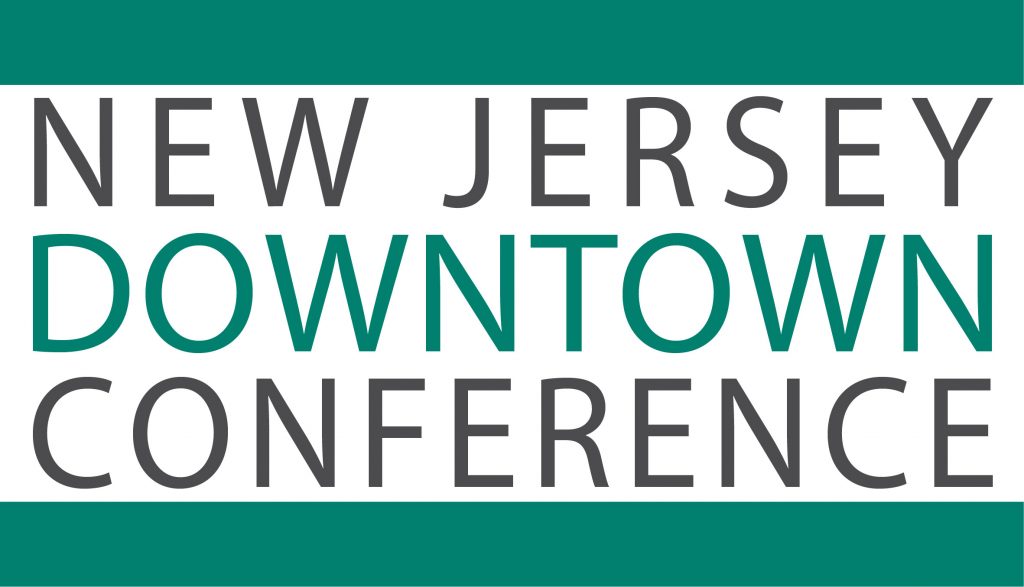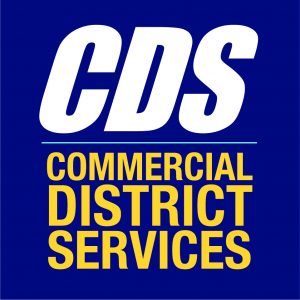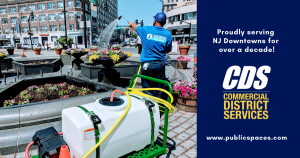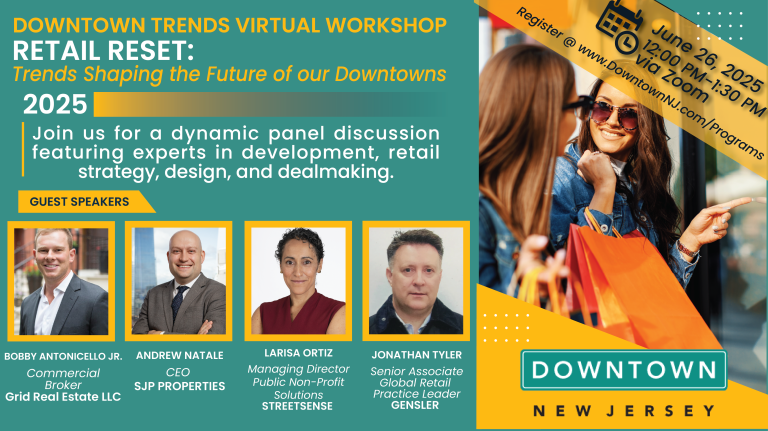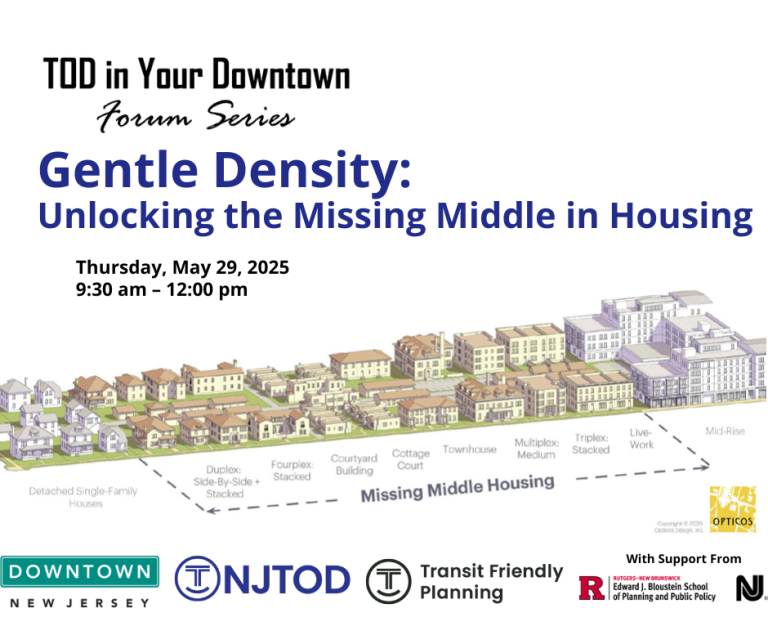Annual NJ Downtown Conference Provides Strategies to Reimagine and Reinvent
Cailean Kok
Downtown New Jersey
February 14, 2022
Statewide non-profit organization hosted industry leaders in real estate and downtown management
Downtown New Jersey’s annual conference and New Jersey’s premiere economic development event, Reimage and Reinvent Downtown, offered insights and lessons into downtown management best practices, as well as development, business, and retail market trends. The two-day online event and networking experience on February 10th and 11th was an action-packed celebration of the value of downtowns as vehicles for providing enormous economic, cultural, and social benefits to communities throughout New Jersey. Throughout the two days and multiple panels and discussions, four key themes and actions came through loud and clear as critical for reimagining and reinvention in our downtowns during this time of recovery:
2022 NJ Downtown Conference in the News:
NJ Downtowns Explore New Technology to Serve Residents, Visitors – New Jersey 101.5
DNJ’s Executive Director Discusses the the Themes and Advice Coming Out of 2022 NJ Downtown Conference with Rhonda Schaffler (Start Min 8) – NJ Business Beat on NJTV
- Intentionality: If you want to create interesting and diverse places, you need to be intentional in who you are working with and how you are working with them. Emerging entrepreneurs are ready and eager, but may need additional assistance, mentorship, and resources to level the playing field.
- Curation: Creating great places takes a curated approach to ensure that you are retaining and attracting diverse businesses to your downtown communities. People want to go to places that offer a variety of services and provide a unique experience.
- Connectedness: Through public spaces, digital realms, and traditional door knocking, communities thrive to the extent that residents, businesses, and consumers are connected and engaged.
- Flexibility: Downtowns must be flexible if they are to thrive over the long term. Whether it is adjusting to long term economic trends, responding to unanticipated global pandemics, or simply addressing the unique and specific needs of a district, success depends on the ability to nimbly take action specific to the problem at hand.
Two years out from the start of the COVID-19 pandemic, panelists agreed that the past few years has provided us an opportunity to reimagine and reinvent the way we operate, creating more innovative solutions that respond to the needs and desires of our downtown communities.
Day 1
The first day of the conference leaned into the topic of equity and inclusion, and also included a discussion about best practices in integrating technology downtown. The morning was kicked off with a welcome from Downtown New Jersey President, Bob Zuckerman, noting that our downtowns are still struggling with the pandemic, but things are starting to look up. Thanks to Downtown New Jersey’s educational opportunities, “we are able to engage with, learn from, and help each other get through this time.” He cited the organization’s 11 downtown management forums, advocacy for liquor license reform, engagement with legislators and state agencies, and ongoing efforts to keep New Jersey’s municipalities and downtowns informed and connected.
Keynote Address
We are at a strategic moment to reimagine and reinvent our downtowns to be more resilient. There is an under tapped resource of property owners, business owners, and professionals that can make our downtowns stronger and more resilient. If we think differently and change how we do our work, we can cultivate entrepreneurship and economic development for people of color. This requires changing investments, policy advocacy, and resource allocation to attract and retain more diverse businesses in our communities.
Lyneir Richardson, Executive Director of the Center for Urban Entrepreneurship and Economic Development (CUEED) at Rutgers University in Newark presented the case for how inclusive strategies lead to economic resilience in his keynote address. He detailed the steps downtown leaders should take to serve and attract diverse interests, and be more welcoming and economically inclusive. He suggested that if we identify and incentivize black entrepreneurs and other people of color to expand and create new businesses, our downtowns will become more vibrant, while also attracting a whole new set of investors and customers.
Outlining how we can become intentionally inclusive, he argues for creating incentives through government and philanthropic partners to invest in diverse operators through buildout allowances, rent abatements, and other strategies; seeking direct input from diverse voices; providing coaching, capacity building, and business support services; and telling the success stories of how investment resulted in new employees, foot traffic, sales, and ratables. “Creating new opportunities for people who have not traditionally been positioned to lead, drive, or own will generate great resilience and create more exceptional downtowns,” he concluded.
Panel Discussion: Inclusive Strategies for Economic Resilience
Our keynote speaker was joined by a panel of distinguished practitioners to discuss real world examples of equitable and inclusive best management practices. Panelists with expertise in economic development discussed strategies for providing capital to small businesses, increasing belonging and inclusion, and removing barriers – all in an effort to build stronger, more resilient local economies.
Natalie Peneiro, Executive Director of the Downtown Somerville Alliance spoke about the need for a curated approach to business retention and recruitment in our downtowns. As she noted, “recruiting complementary and diverse businesses make downtowns more walkable and directly impacts [customer] turnover in businesses.” With the COVID-19 pandemic, it has been difficult to attract new businesses or get businesses to open secondary locations. So, Downtown Somerville prioritized relationship building. They worked with a retail consultant to help set the agenda, curate prospective businesses, and start relationship building. Another effort to engage the community during the COVID-19 pandemic, included the transformation of the Division Street pedestrian mall into a mural installation that celebrated Black innovation. She noted that the installation, “helped drive foot traffic in the district when it was otherwise desolate,” and got people to make a “day of being in Somerville…while people were there experiencing the walk, they were also shopping and dining.”
Building on the need for a curated approach, Aisha Glover, Vice President of Urban Innovation at Audible, Inc. noted that, “we want our downtowns to be fun, full of options, and have a vibe” and that this “doesn’t happen by accident. It takes a level of intentionality to make sure our downtowns don’t look like any town USA.” As a major corporate presence in the City of Newark, Audible, Inc. has taken steps to make investments in small businesses by getting their employees to participate in the local economy. Through their Lunch Out Wednesday program, they incentivize staff to spend money in the community by providing a gift card to purchase lunch locally. On top of that, every new hire goes on a walking tour to physically introduce them to the downtown business community. Of course, in March 2020, like many downtowns, there was a dramatic absence in corporate and institutional foot traffic, so Audible, Inc. pivoted and worked with community partners to create Newark Working Kitchens to fill the gap. They procured meals from local restaurants and distributed them to the people that needed them the most, including senior centers, public housing, and homeless shelters. They have since expanded their efforts to include the Newark Artists Collaboration, which is investing in the artist community to do installations in their corporate space, as well the surrounding neighborhood. This effort both beautifies the neighborhood and fuels local artists.
Rafael Mata, Senior Consultant to the Small Business Development Center of New Jersey (NJSBC) argued that “diversity and inclusion represents new markets for businesses, so it is the right thing to do, but it is also the profitable thing to do.” He described available resources, and NJSBDC’s technical assistance to help small businesses access these resources. He noted that the CARES (Coronavirus Aid, Relief, and Economic Security) Act provided many financial opportunities for minority, women, and veteran owned businesses to take advantage of federal, state, and local resources. These programs were intended to reignite the economy and create opportunities for micro businesses in New Jersey; however, the pandemic revealed that many of these businesses were not able to access these resources without first getting their records in compliance. This is where the NJSBDC came in to help level the playing field, offering mentoring and assistance in navigating and connecting the dots for businesses to access these resources. As part of this effort, they continue to offer virtual application walk throughs for women, minority, and veteran businesses.
At the conclusion of the discussion, the panelists agreed that in the current economy, we can’t afford to be siloed and that it is important to come together and think about what economic recovery will look like. There is a need to be more mindful about businesses’ capacity, expertise, and access to resources, and be more intentional about the resources made available. Communication is a key component to increasing access to resources because, as Mata noted, “businesses are dealing with a lack of hope. And if they don’t see it, they don’t think it is happening,” so we need to “publicize the small victories” to help motivate others.
Panel Discussion: Becoming a Tech Savvy Downtown
Technology is becoming a large part of efficiently managing downtowns. From scooters and bike share to parking to staff supervision, savvy downtowns are making the user experience better and management easier by integrating new technology. Panelists discussed their experience using technology to better manage commercial districts, to make the districts more accessible, to connect people and businesses to technology, and to connect businesses to a larger customer base.
Chris Bernardo, President and CEO of Commercial District Services (CDS) began the panel discussion by providing insights into the ways CDS has used technology to better connect with and meet the expectations of their clients. Digital data collection enables better identification of neighborhood priorities, which can then be reflected in budgets. Technology also helps implement these priorities by better tracking regular services. The expansion of more affordable video camera systems can also supplement community police services. He noted that “with WiFi communications, we’re seeing more systems today where, for instance, you can monitor the level of trash cans. And you can sort of manage things that were traditionally never connected to technology.” Finally, the centralized collection of data through technology makes it easier to communicate results and progress to stakeholders.
Michael Manzella, Deputy City Manager and Director of Transportation in the City of Asbury Park discussed how they are using technology to enhance mobility and accessibility in and around its commercial districts and tourist destinations. Asbury Park implemented a scooter share program that leverages GPS technology to minimize the problems commonly associated with other scooter share programs. Asbury Park designated parking hubs, and requires scooters to be returned to the hub before a ride can come to an end. This helps avoid the issue of scooters strewn across the city. Creation of the hubs also allowed Asbury Park to ensure that the scooter service was available throughout the city, and not just in select neighborhoods. Furthermore, Asbury Park uses geo-fencing to create slow zones and no-ride zones to ensure public safety in more pedestrian focused areas, like Cookman Avenue. He said, “Overall, the program has been a huge success. We have a really high utilization rate in Asbury Park…that really tells us that residents and others that come to the city are using it to access businesses and destinations they need.”
Vanessa Quijano, Senior Vice President of Business Development at Invest Newark followed up with ways to make technology more accessible to the public and local businesses. Newark Fiber is providing low-cost internet service to businesses and apartment buildings in downtown Newark, with planned expansions into other neighborhoods and service to individual households. Meanwhile, LinkNWK provides high speed internet access at kiosks and public WiFi throughout downtown Newark with plans to expand into all five wards. She pointed out, “It’s not just about bridging the digital divide anymore. Internet access is a utility at our fingertips, and we want to ensure that we all have access at home, at work, and at public spaces.”
Jef Buehler, Leader of the Neighborhood Preservation Program in the New Jersey Department of Community Affairs provided insight into how technology can be used to connect local businesses with a wider customer base. For example, Perth Amboy created the website perthamboyeats.com to serve as a central point of information for local restaurants. The website is mobile friendly and provides information about restaurant menus, hours, and dine-in, take-out and delivery options. For many restaurants, this was their first opportunity to present themselves and their food on the web. This virtual service was then brought into the physical world with an accompanying food tour.
In New Brunswick, local businesses were promoted and supported with a e-gift card program for businesses in the French Street neighborhood. This program brought businesses together and created a branded identity for the area. Buehler noted that various strategies can be used to connect businesses to customers through technology with varying levels of effort, saying, “There are a lot of turnkey solutions out there that can be used where the infrastructure is built, it’s proven to work, nationally, internationally in some cases. And so why reinvent the wheel if, for a modest fee or in some cases no fee, like the gift card program, you can just literally plug in the info and its up and running in two weeks.”
Finally, Bob Zuckerman, Executive Director of Downtown Westfield shared his experience implementing an EV charging station program. Afterwards, he moderated a discussion among the panelists that centered on strategic selection of new technology.
Day 2
The second day of the conference featured a virtual discussion among real estate and redevelopment experts about reimagining 20th Century space for 21st Century demand. The morning also included a virtual opportunity to network with sponsors and colleagues.
Panel Discussion: Reimagining the White Elephant
Many of our towns and cities are home to ‘white elephants’ – large scale developments that were conceived in decades past and have become unloved and underutilized due to changes in society since they were constructed. The session panelists discussed approaches to rethink and repurpose these projects to not only create new spatial typologies, but also respond to critical shifts toward equality and sustainability.
Roger Smith, Design Director at Gensler, began the panel by outlining trends in commercial real estate redevelopment. He explained that struggling malls and suburban corporate campuses have an opportunity to become community assets. He noted that even in the suburbs, we are seeing that well planned density and shared urban experiences have not gone away, and are still very much sought after. We are also realizing that, in the post pandemic world, open community space is more important than ever. Finally, he explained that enhancing the public realm will strengthen our downtowns; and in doing so, strengthen our communities. He concluded that, “across the country, we are rethinking our future and discovering new opportunities and finding value by reimagining these white elephants.”
Richard Heapes, Co-founder and Partner of Streetworks Development followed with some thoughts about how to reimagine, reinvigorate, and reactivate these spaces. He discussed the need to create flexible spaces that can change and respond to the market. He argued that spaces need to support employees, including childcare, pet care, and exercise facilities, which have positive impact on employees’ quality of life. Space for collaboration is also important. He concluded that, if we “help activate the space, we make it more interesting, and create a sense of community.”
Jonathan Schultz, Co-Founder and Managing Principal of Onyx Equities presented his work to turn Newark’s Gateway Center “inside out” and make it open to community. He noted that as they took on this project, they knew it would be all about community and how to make the space more inviting to both tenants and the larger public. He noted that, in the post COVID-19 world, it will be important to create places that people feel excited to come back to and enjoy each other’s company. To this point, Onyx curated the Gateway Center as a place for the community to come and use. This includes collocating restaurants, grocery, daycare, and fitness facilities.
Ralph Zucker, President of Somerset Development presented the transformation of the former Bell Labs in Holmdel, repurposing 2 million square feet of vacant office and lab space to create a Metroburb – a metropolis in the suburbs. He noted that the hardest part was getting community to buy in. In the process, he “learned that even suburbanites love urban community.” They took the assets of the corporate campus – the large communal space that was closed off to the public – and transformed them into spaces that invite the community in. They discovered that the biggest amenity of an office complex is “the people and life itself”. By opening their doors and creating spaces for people to enjoy, they created a place where everyone wants to be. He noted that when the project started, the market had a 30% vacancy rate; yet today, they are closing in on 100% occupancy. With that, they “have proven that life and people are the ultimate amenity…even a pandemic cannot keep people away from each other. There is a hunger for people to come, join, meet, and collaborate with each other.”
Michael G. McGuinness, Chief Executive Officer at NAIOP NJ discussed the advocacy work that his organization engages in to support commercial real estate initiatives. They worked with the legislature to expand the Local Housing & Redevelopment Law criteria to include stranded assets. Since the pandemic, NAIOP NJ has been encouraging the New Jersey Economic Development Authority (NJEDA) and state legislators to designate certain stranded assets as targeted areas for research and development. This would help these suburban assets, such as the former Bell Labs, become ready for occupancy by emerging companies looking to come to New Jersey.
The panelists noted that the largest white elephant was actually the COVID-19 pandemic. Schultz noted that the pandemic accelerated and changed the way people think; and as such, everyone has a new sense of freedom about how they can operate in their companies. He explained that “we better make it exciting, inviting, open, happy, and fun…as we move forward!” In agreement, Heapes thinks that flexibility will be important as we move forward. “Before the pandemic, you flexed to the [real estate] world, and now it is the reverse, the [real estate] world flexes towards the individual.” Real estate will have to flex to quality-of-life demands, and that this will ultimately lead to new innovations.
Missed a session or the whole conference?
All of the videos, PowerPoints, and referenced resources from the conference are available to view on the conference website. Registered conference attendees can use their existing login credentials to access the videos and materials.
Didn’t register for the conference? You can still register at a reduced rate to gain access to recordings of conference sessions. More info>

